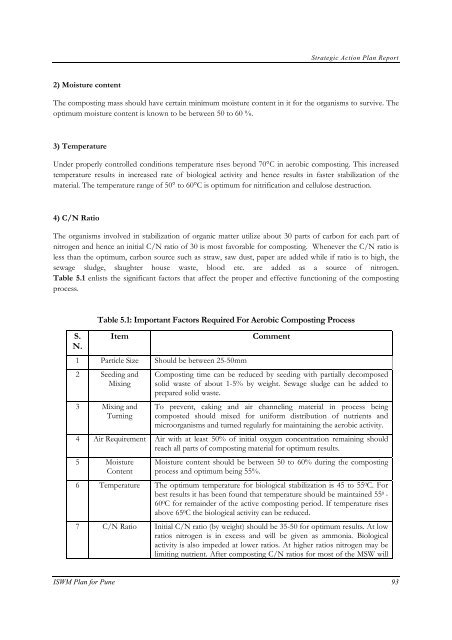Strategic Action Plan - International Environmental Technology Centre
Strategic Action Plan - International Environmental Technology Centre
Strategic Action Plan - International Environmental Technology Centre
Create successful ePaper yourself
Turn your PDF publications into a flip-book with our unique Google optimized e-Paper software.
<strong>Strategic</strong> <strong>Action</strong> <strong>Plan</strong> Report<br />
2) Moisture content<br />
The composting mass should have certain minimum moisture content in it for the organisms to survive. The<br />
optimum moisture content is known to be between 50 to 60 %.<br />
3) Temperature<br />
Under properly controlled conditions temperature rises beyond 70°C in aerobic composting. This increased<br />
temperature results in increased rate of biological activity and hence results in faster stabilization of the<br />
material. The temperature range of 50° to 60°C is optimum for nitrification and cellulose destruction.<br />
4) C/N Ratio<br />
The organisms involved in stabilization of organic matter utilize about 30 parts of carbon for each part of<br />
nitrogen and hence an initial C/N ratio of 30 is most favorable for composting. Whenever the C/N ratio is<br />
less than the optimum, carbon source such as straw, saw dust, paper are added while if ratio is to high, the<br />
sewage sludge, slaughter house waste, blood etc. are added as a source of nitrogen.<br />
Table 5.1 enlists the significant factors that affect the proper and effective functioning of the composting<br />
process.<br />
S.<br />
N.<br />
Table 5.1: Important Factors Required For Aerobic Composting Process<br />
Item<br />
1 Particle Size Should be between 25-50mm<br />
2 Seeding and<br />
Mixing<br />
3 Mixing and<br />
Turning<br />
Comment<br />
Composting time can be reduced by seeding with partially decomposed<br />
solid waste of about 1-5% by weight. Sewage sludge can be added to<br />
prepared solid waste.<br />
To prevent, caking and air channeling material in process being<br />
composted should mixed for uniform distribution of nutrients and<br />
microorganisms and turned regularly for maintaining the aerobic activity.<br />
4 Air Requirement Air with at least 50% of initial oxygen concentration remaining should<br />
reach all parts of composting material for optimum results.<br />
5 Moisture<br />
Content<br />
Moisture content should be between 50 to 60% during the composting<br />
process and optimum being 55%.<br />
6 Temperature The optimum temperature for biological stabilization is 45 to 55 0 C. For<br />
best results it has been found that temperature should be maintained 55 0 -<br />
60 0 C for remainder of the active composting period. If temperature rises<br />
above 65 0 C the biological activity can be reduced.<br />
7 C/N Ratio Initial C/N ratio (by weight) should be 35-50 for optimum results. At low<br />
ratios nitrogen is in excess and will be given as ammonia. Biological<br />
activity is also impeded at lower ratios. At higher ratios nitrogen may be<br />
limiting nutrient. After composting C/N ratios for most of the MSW will<br />
ISWM <strong>Plan</strong> for Pune 93
















